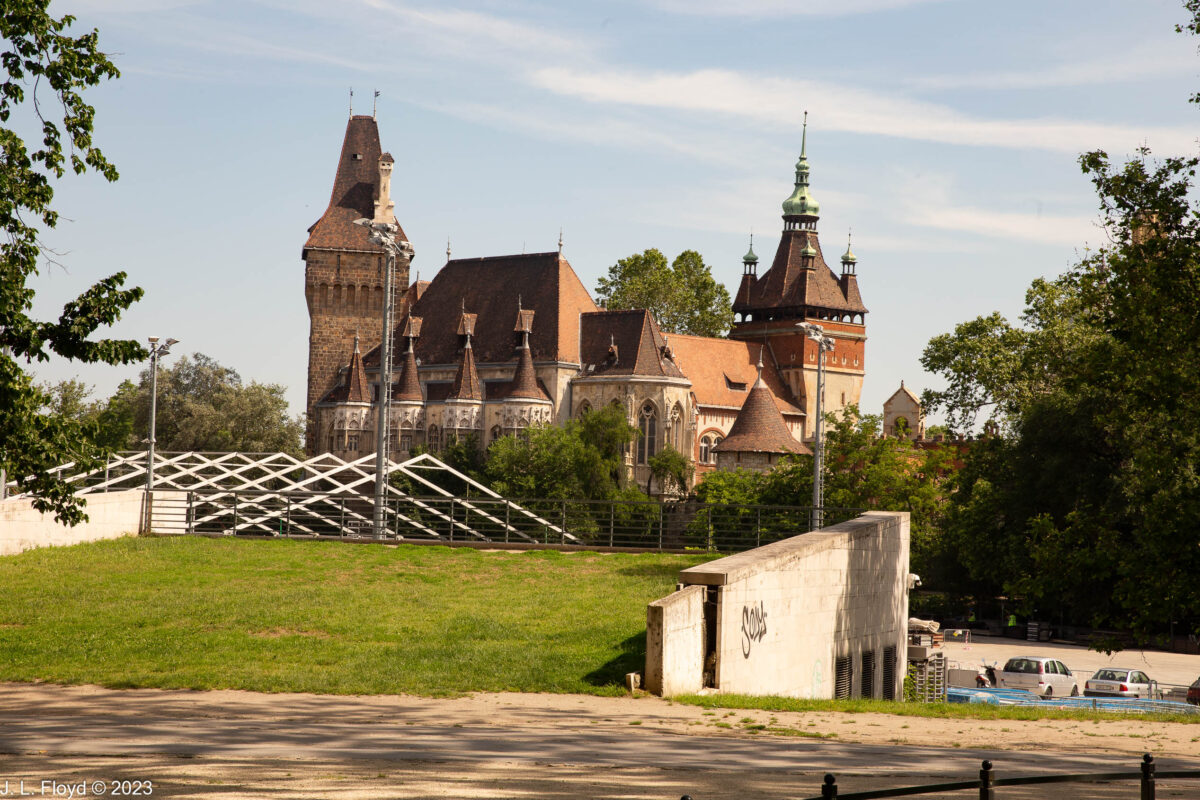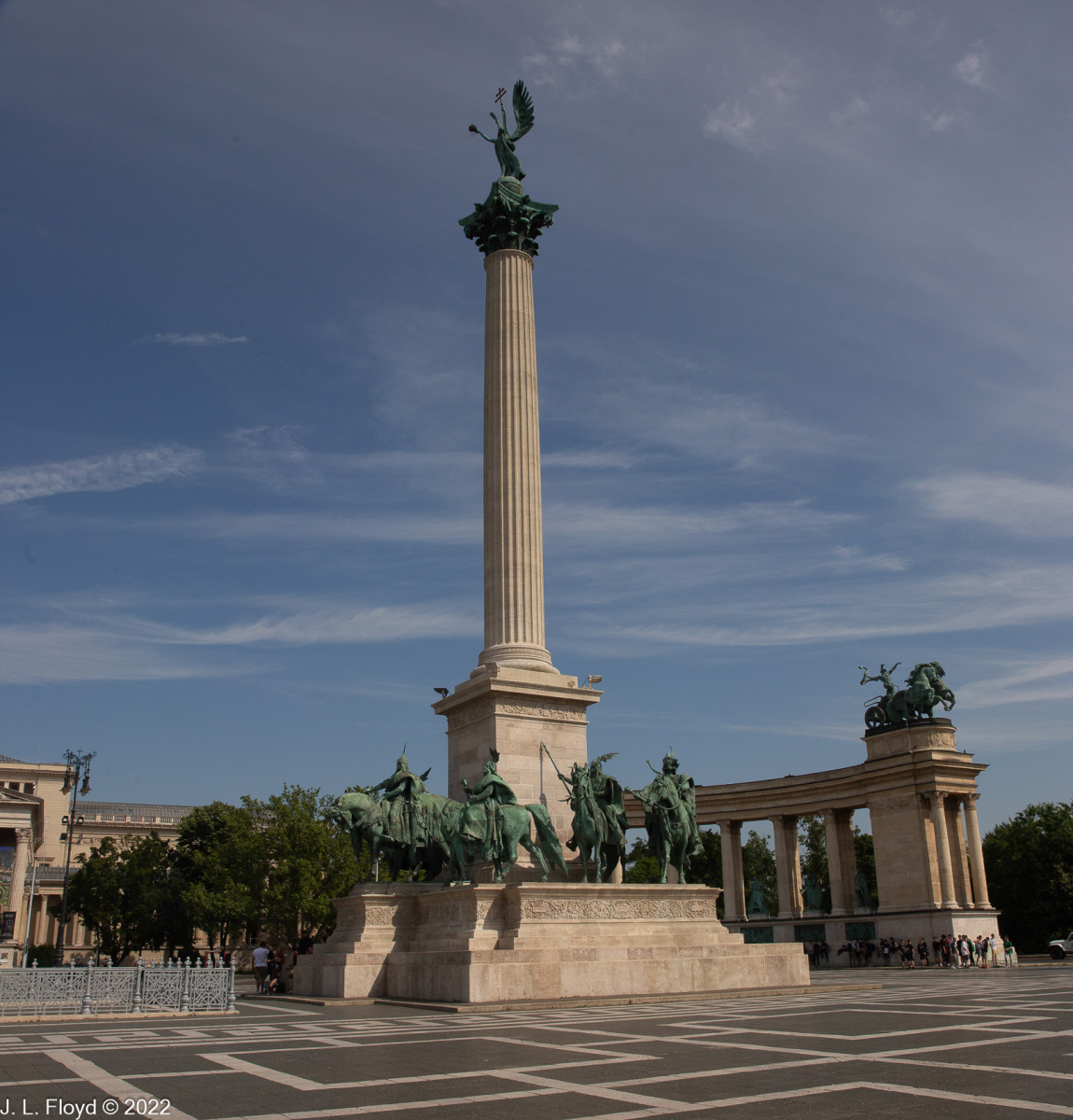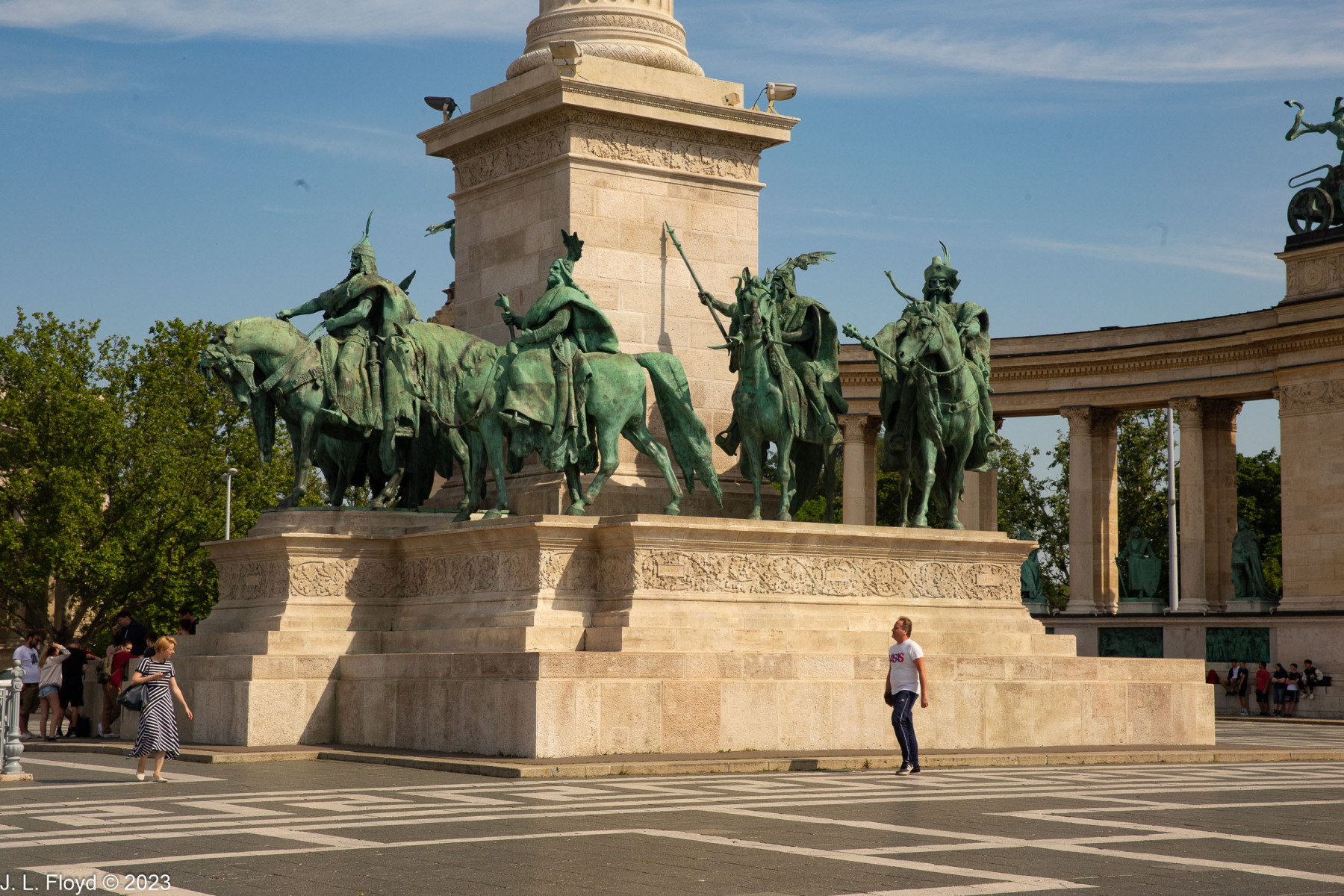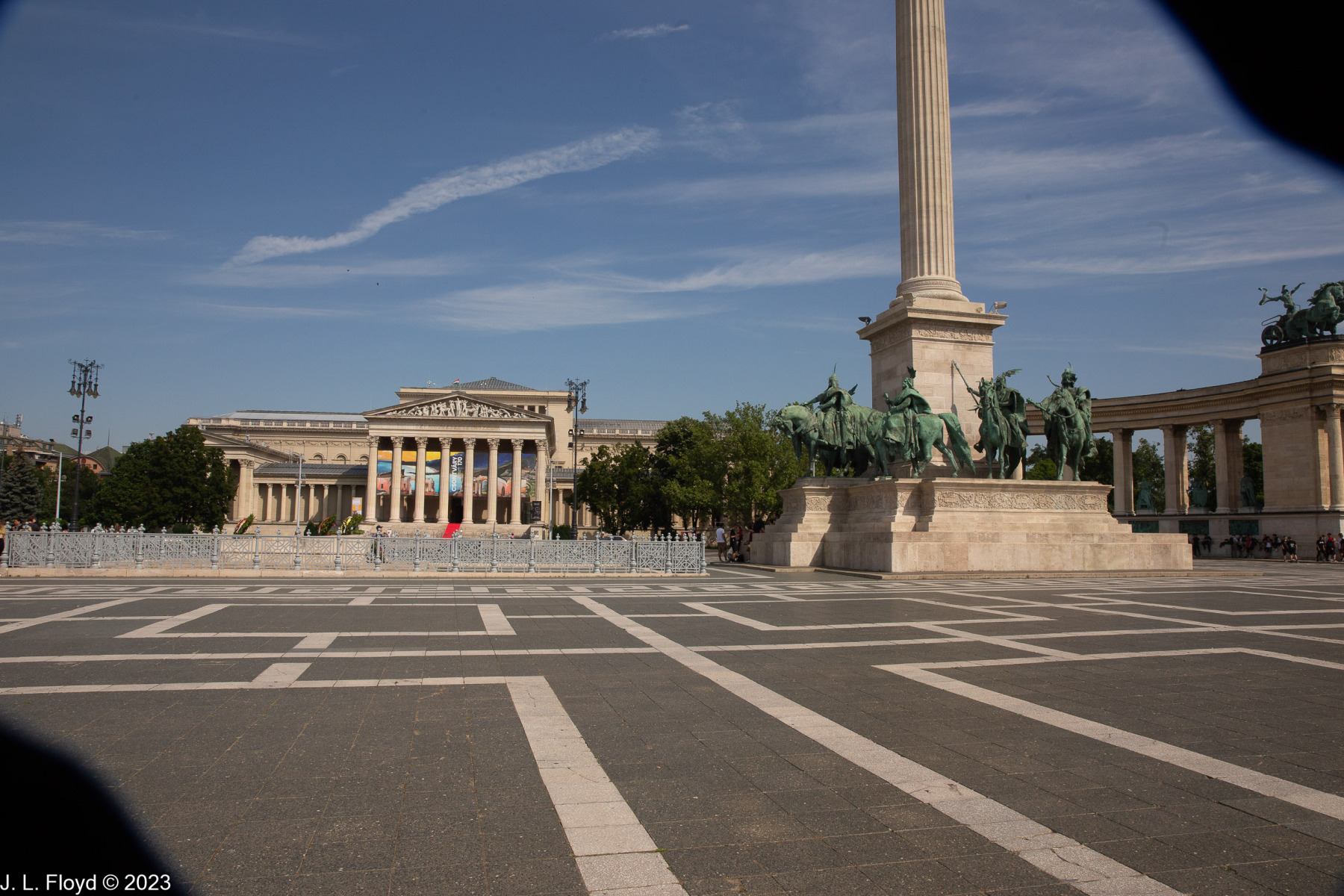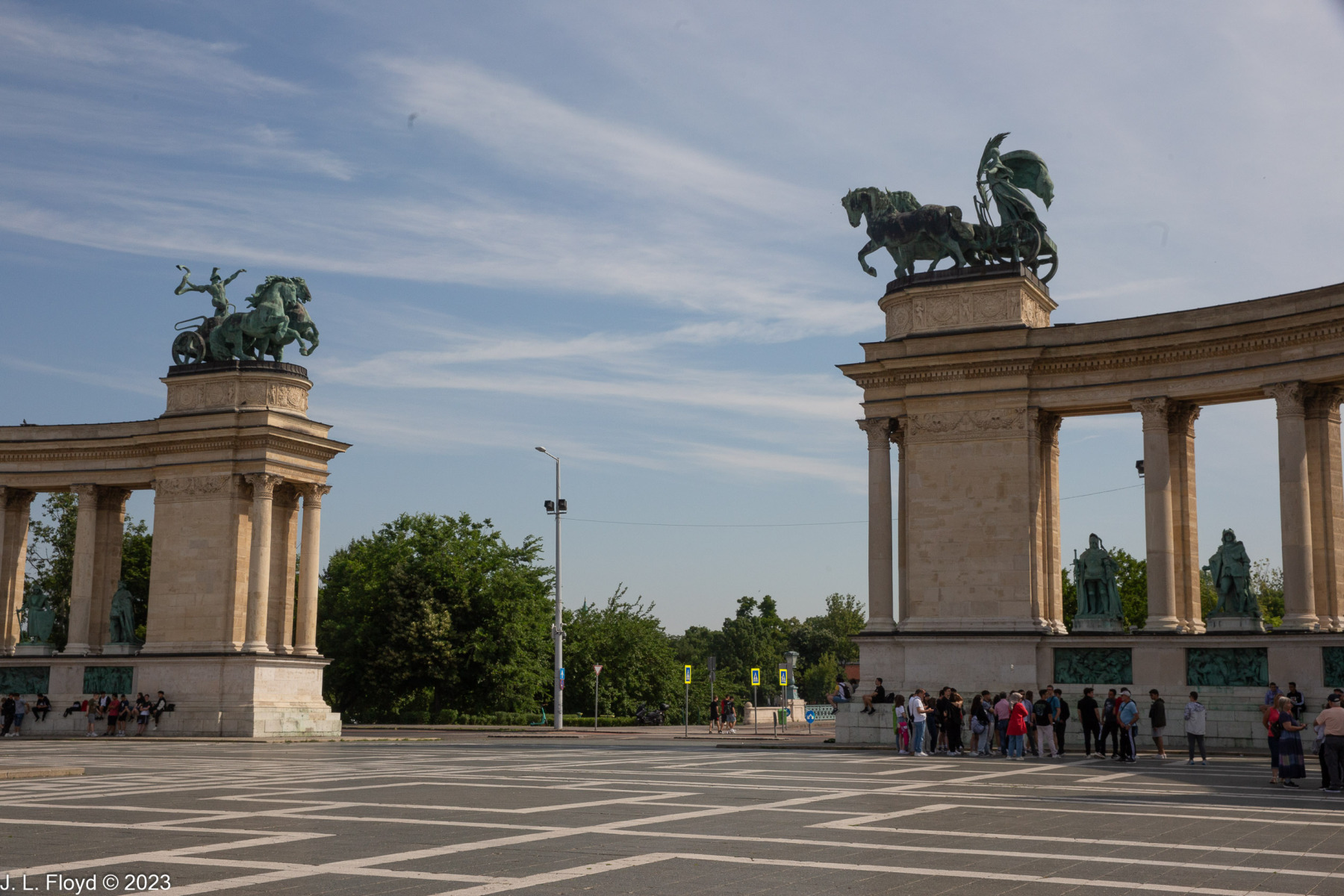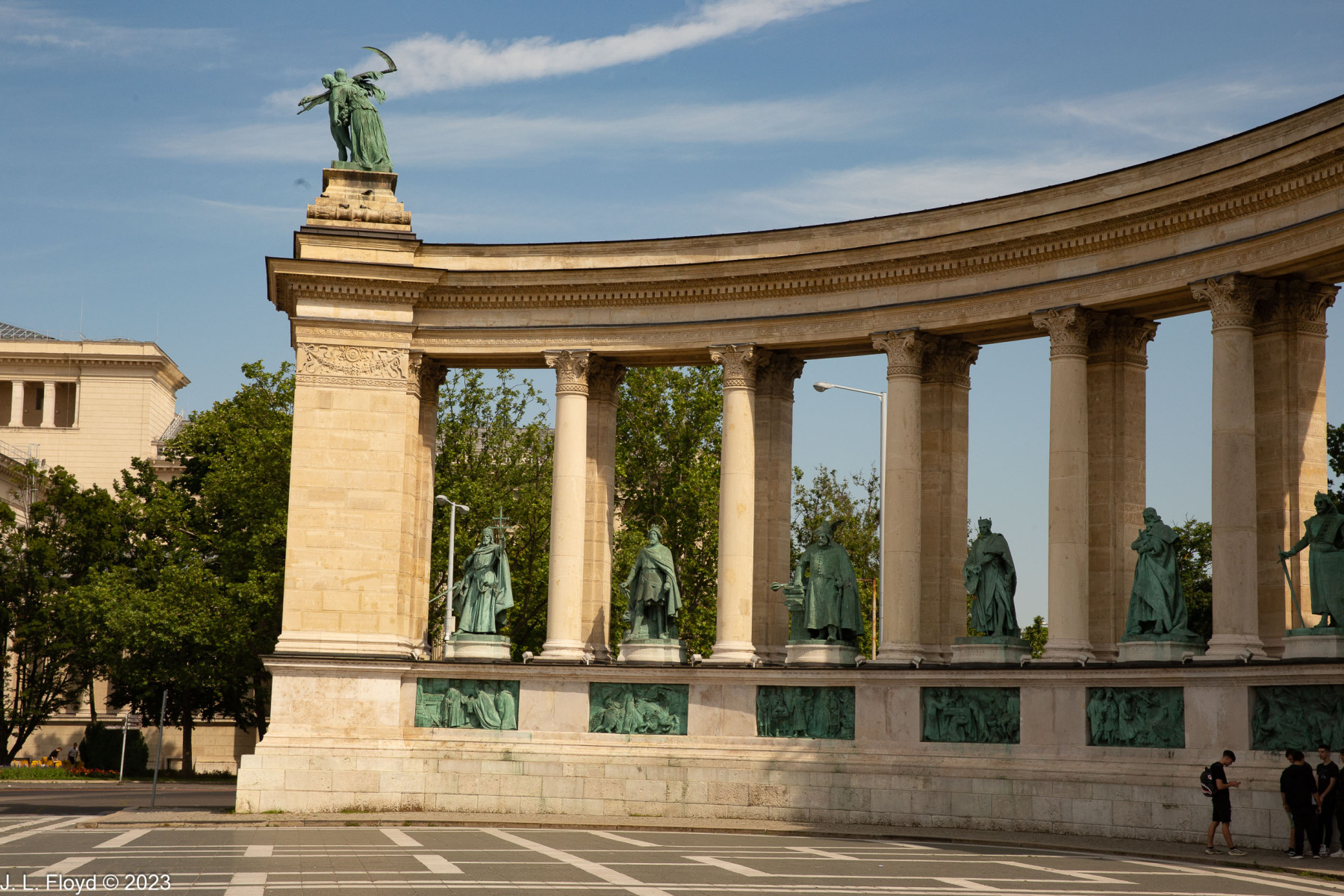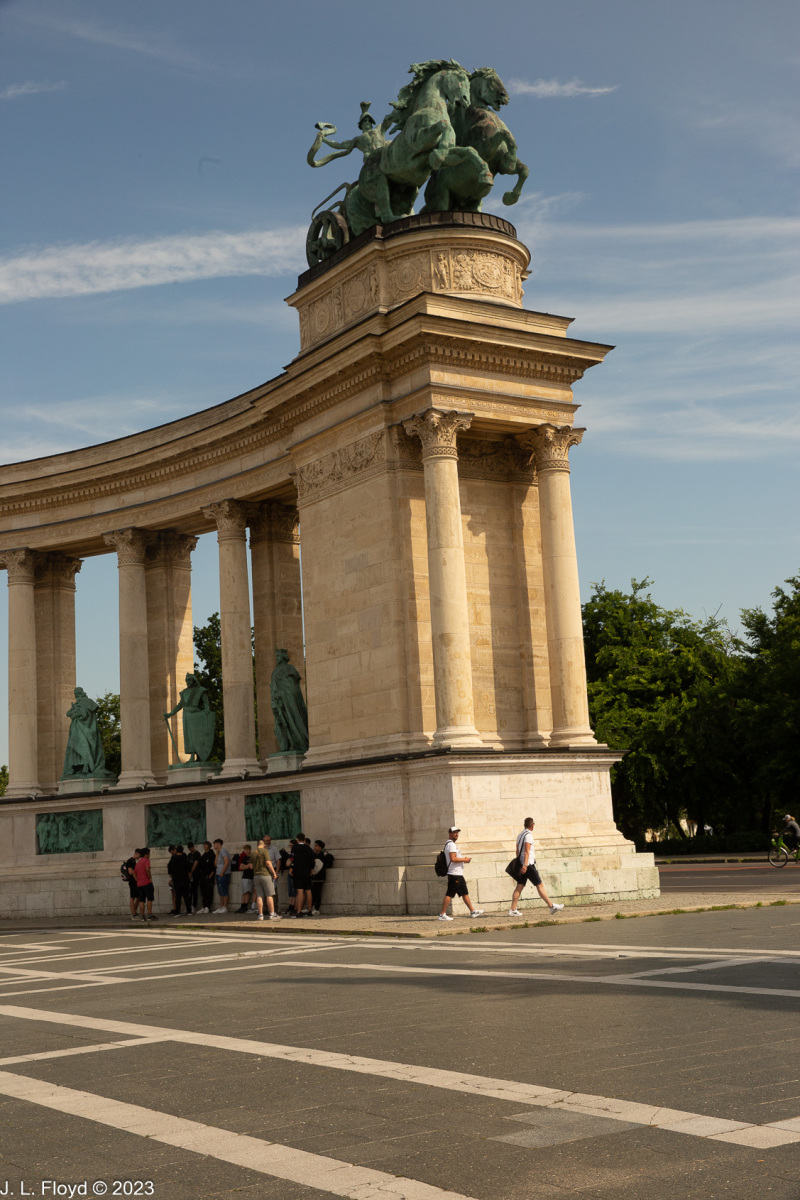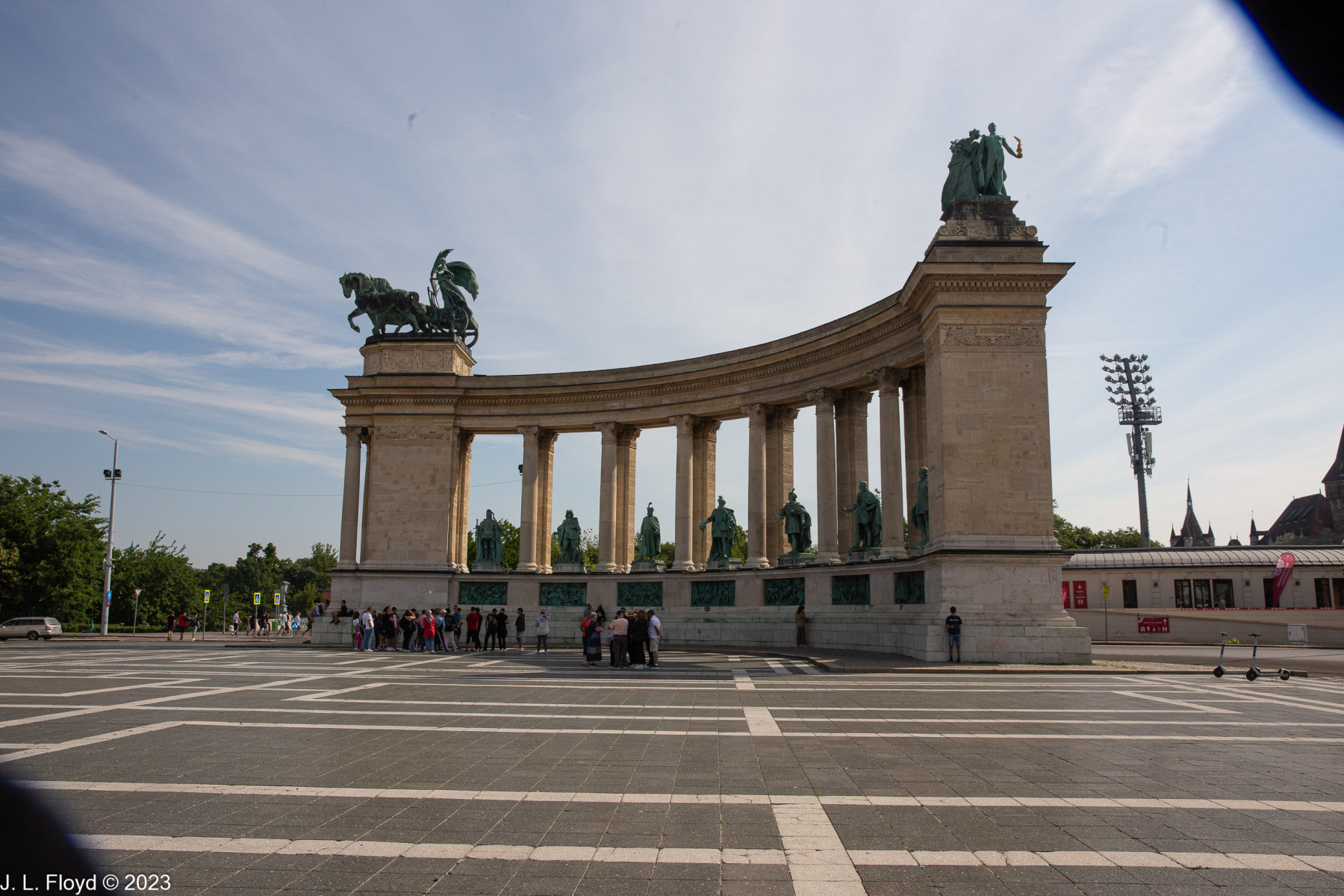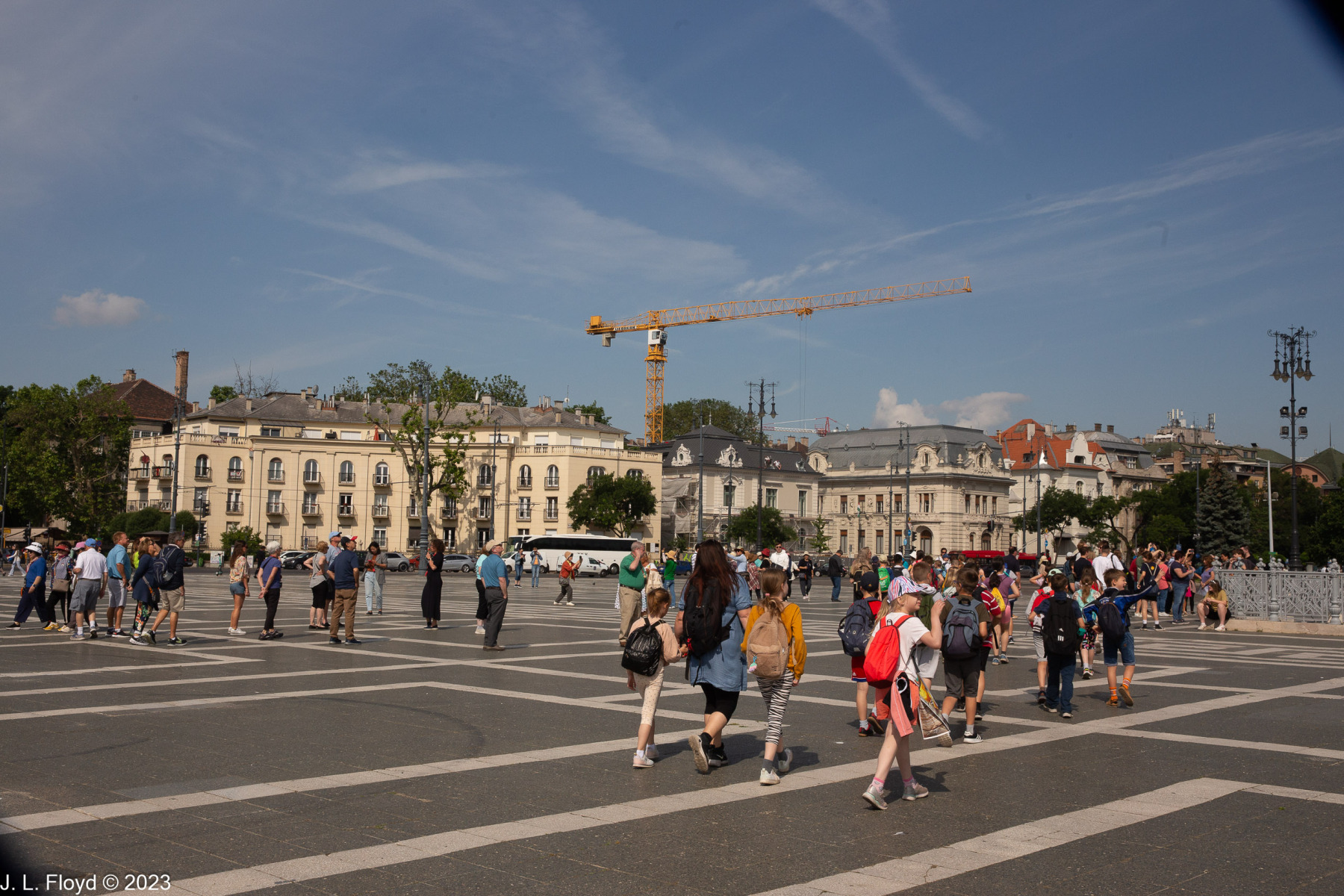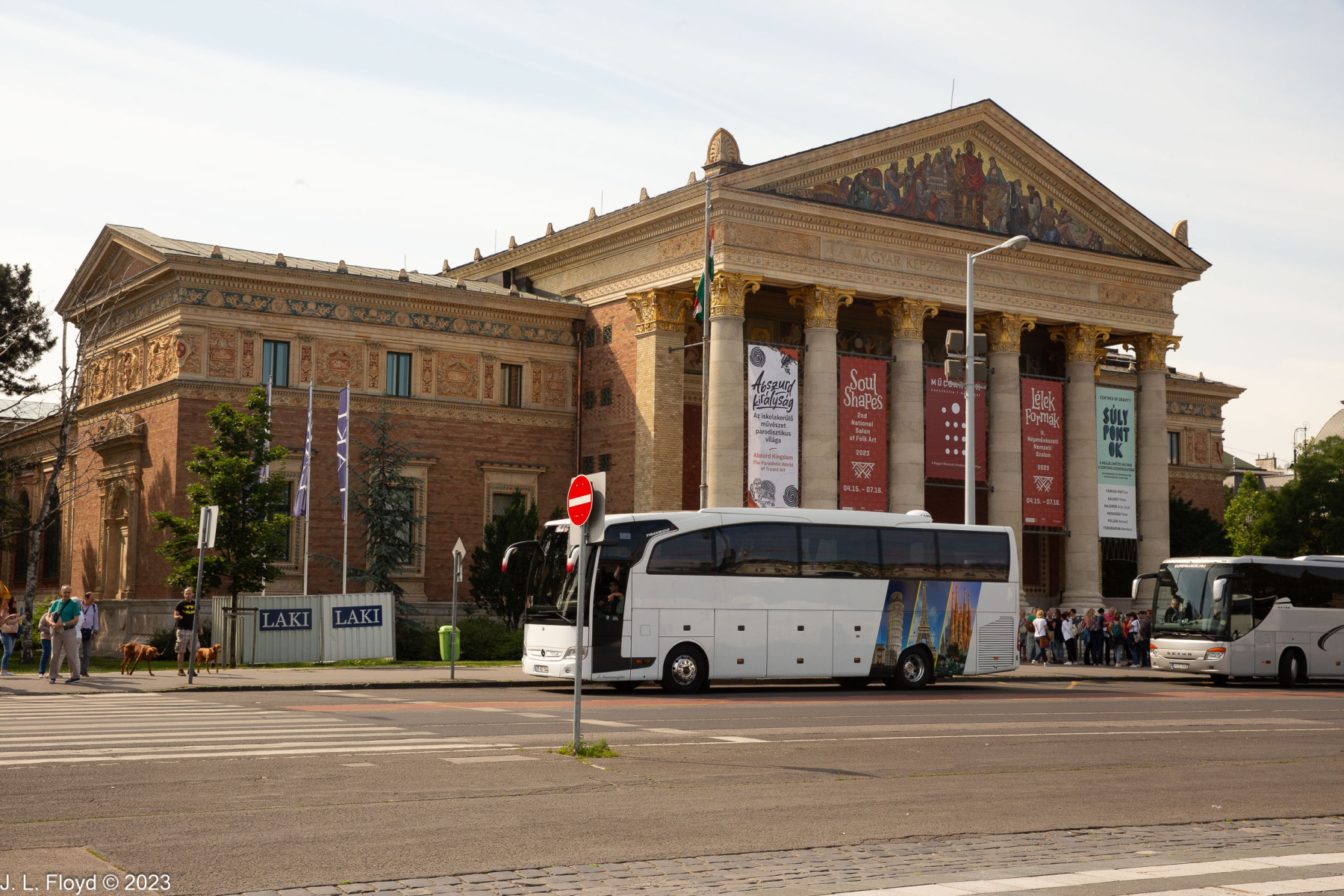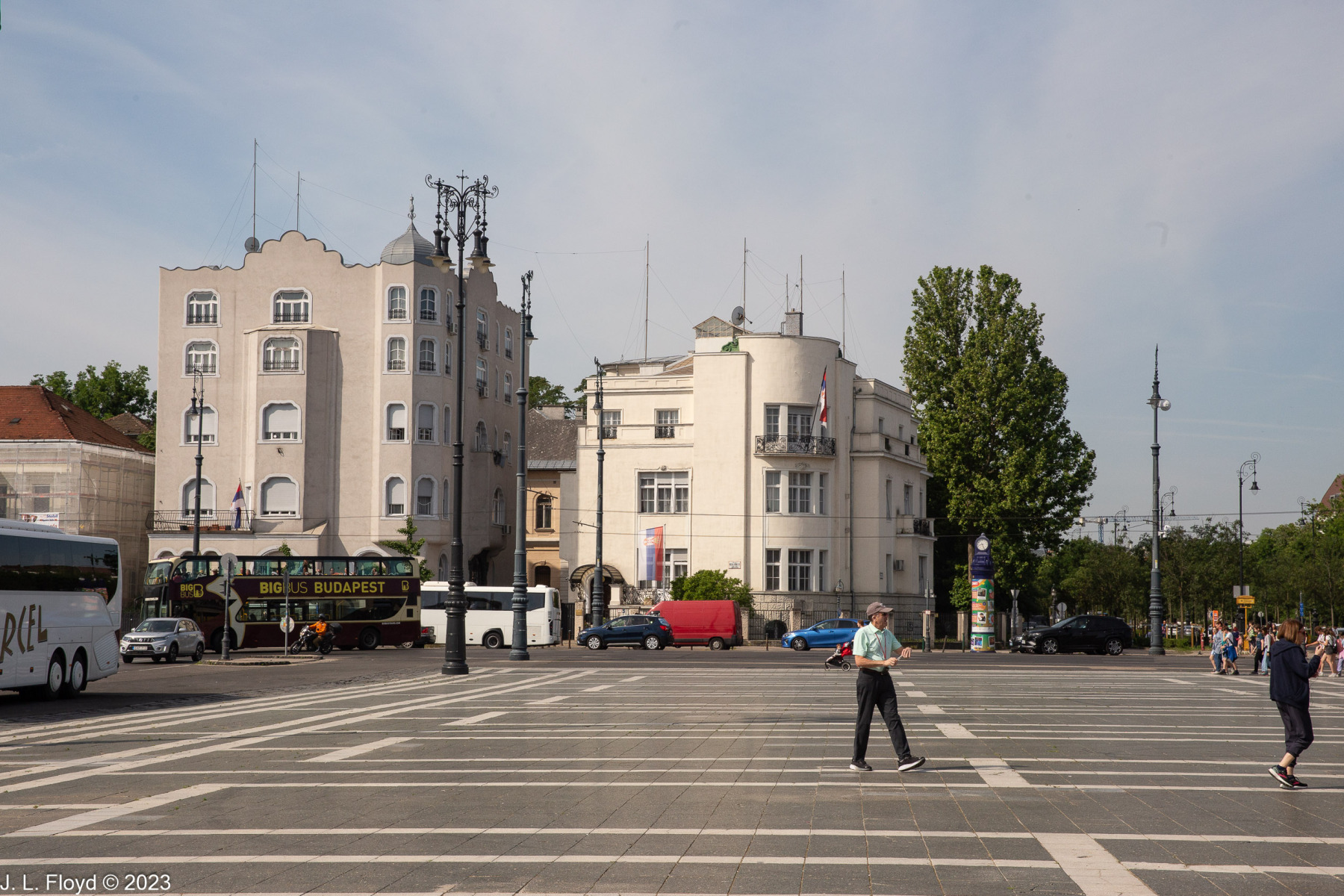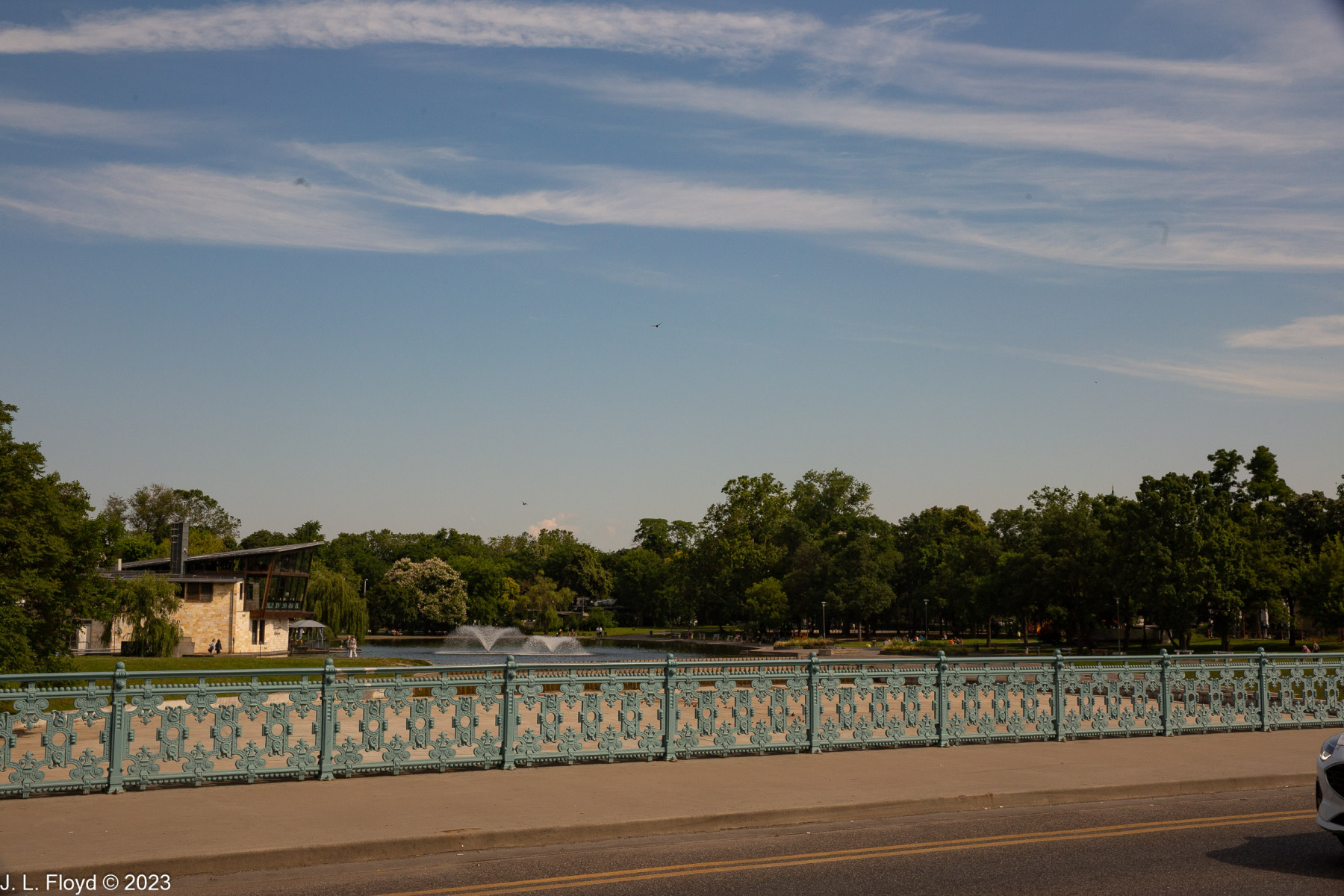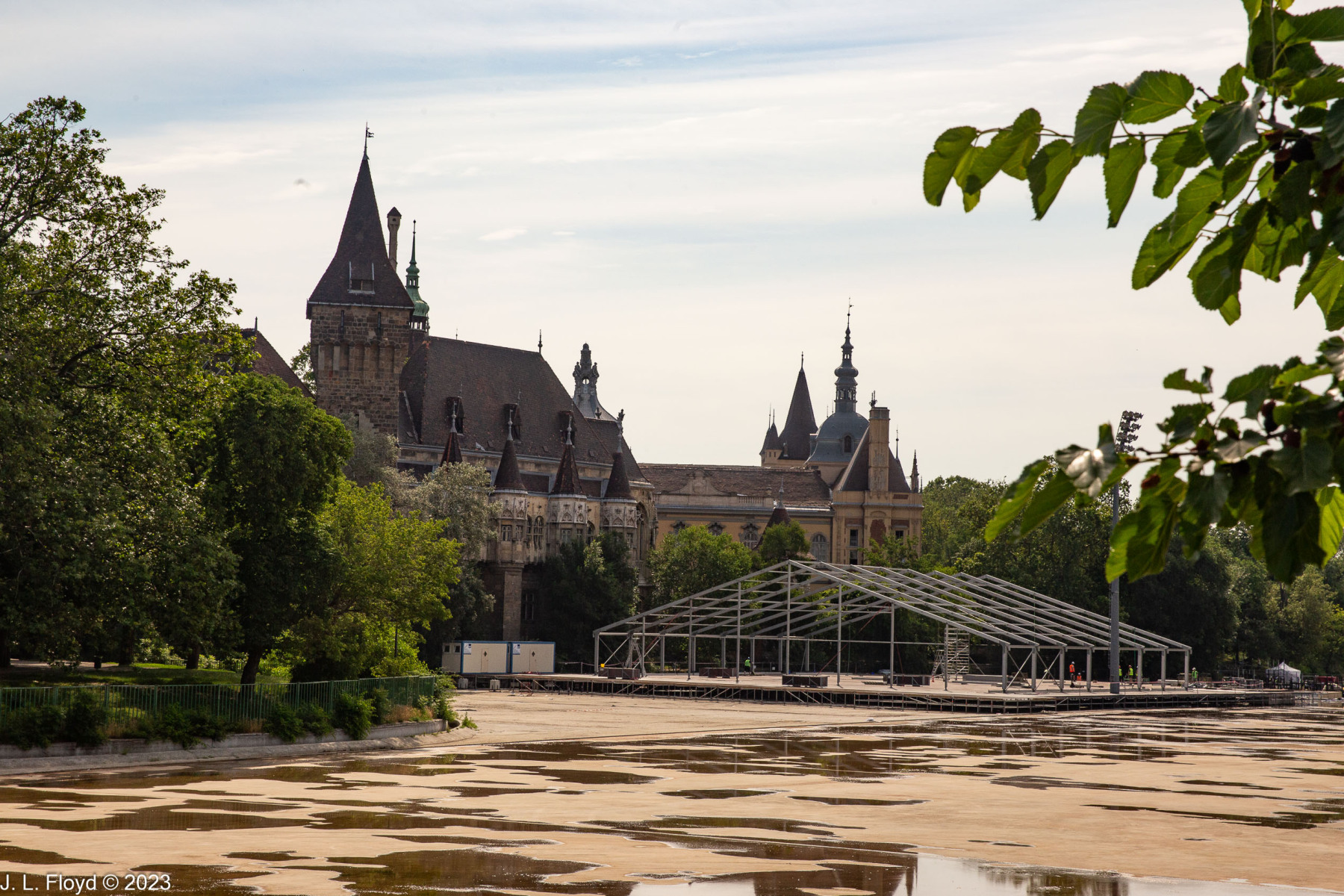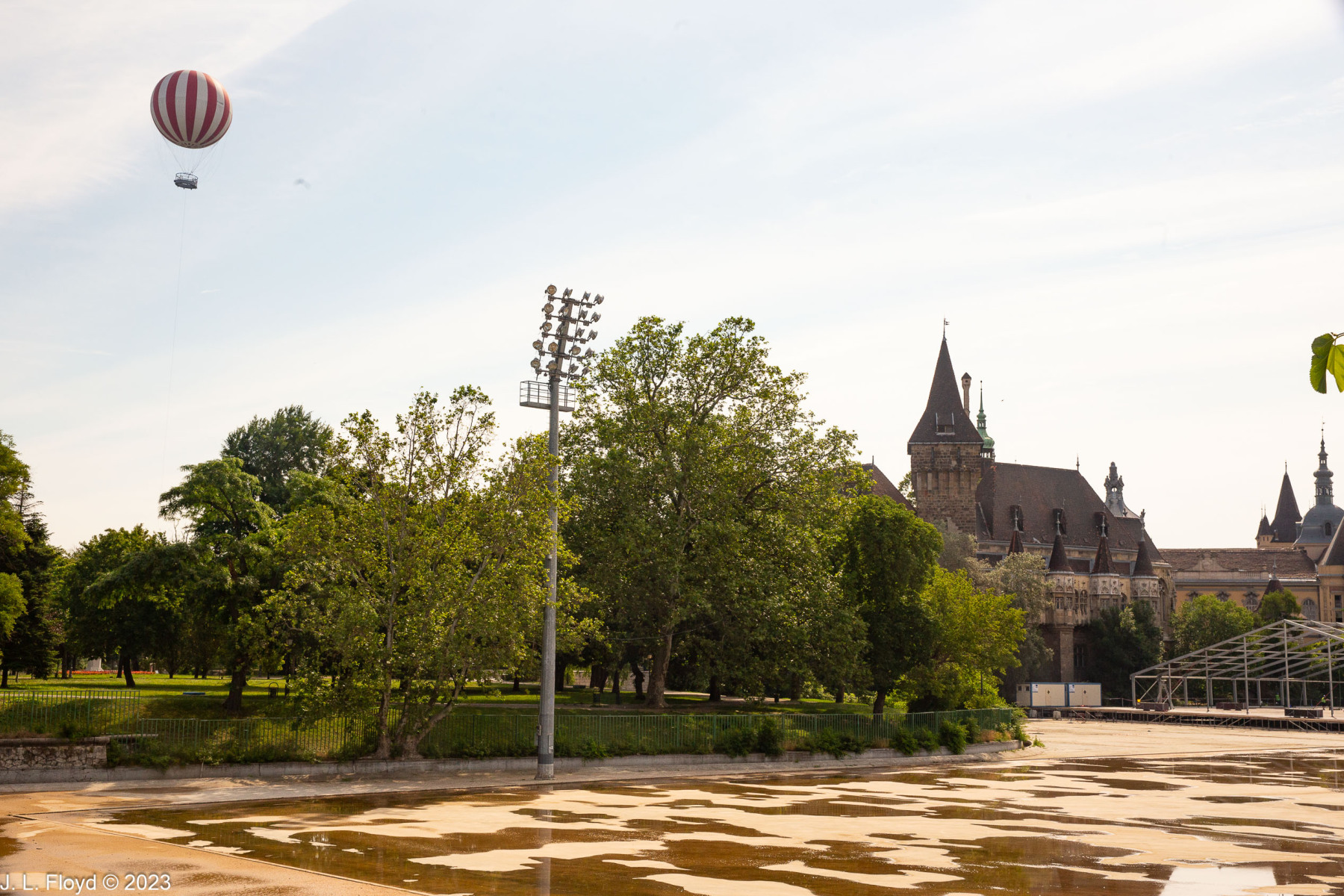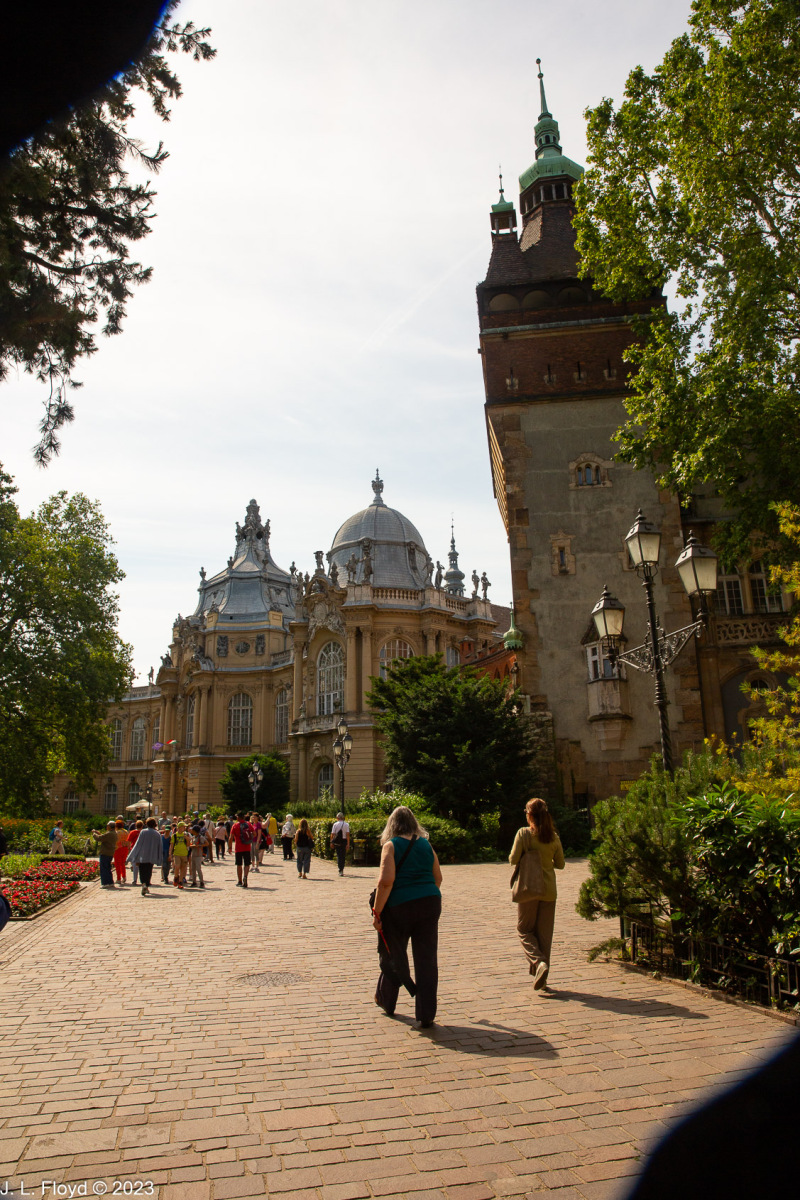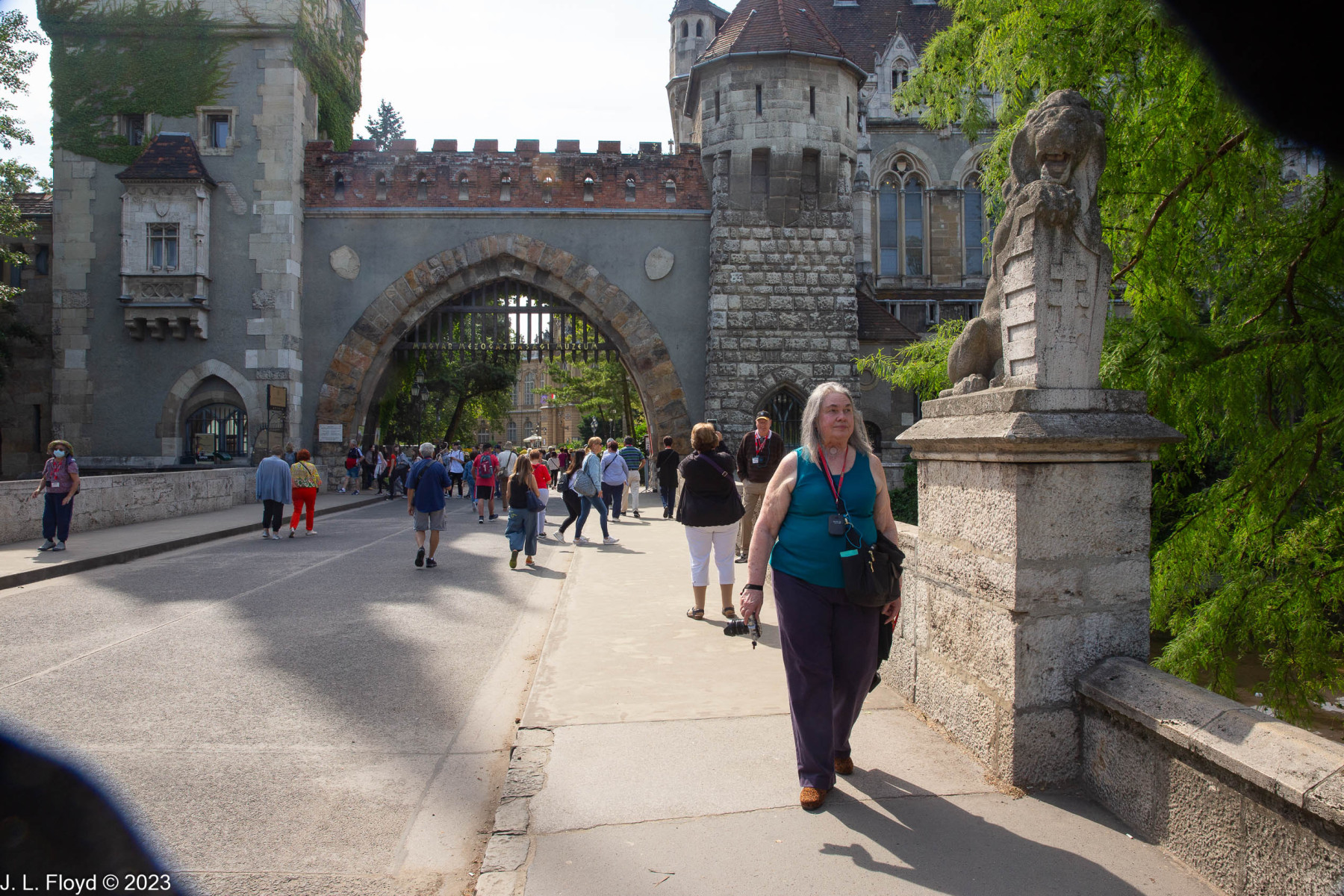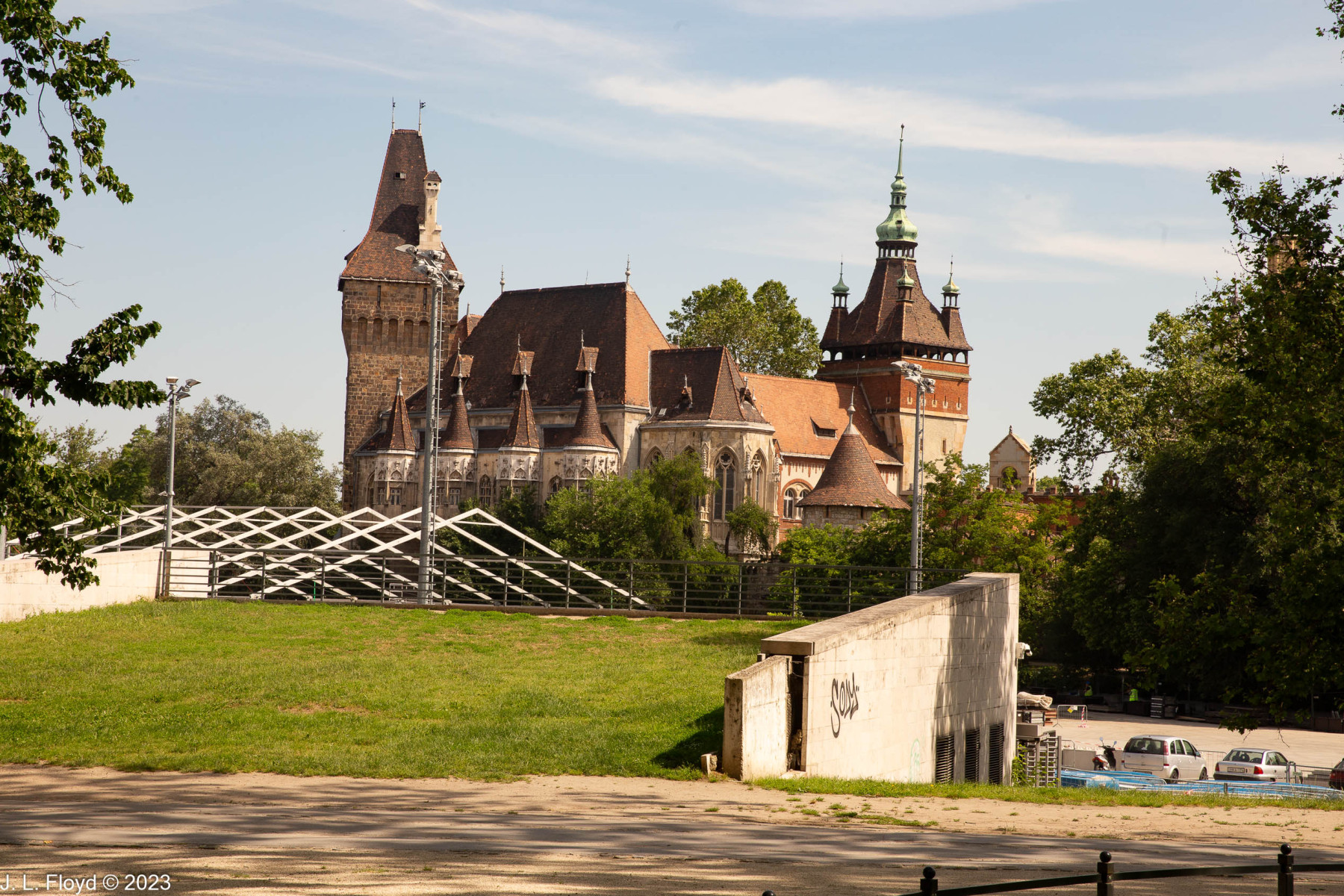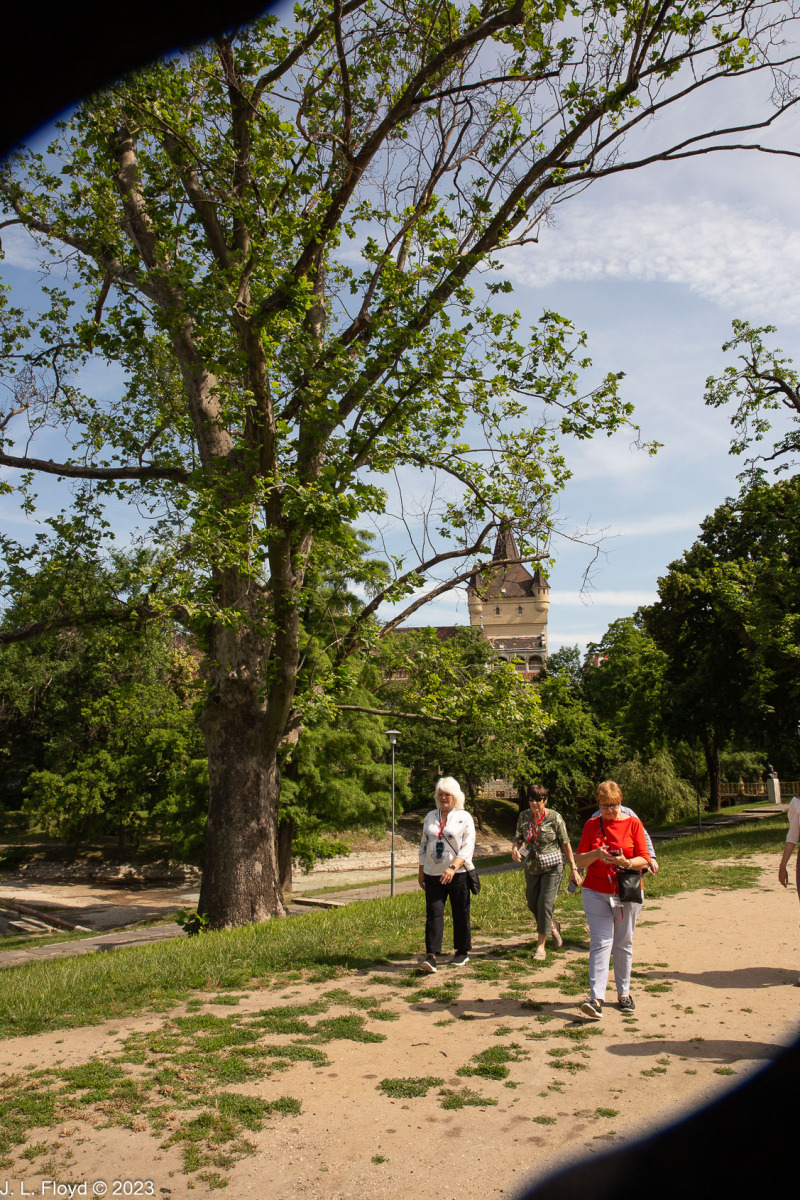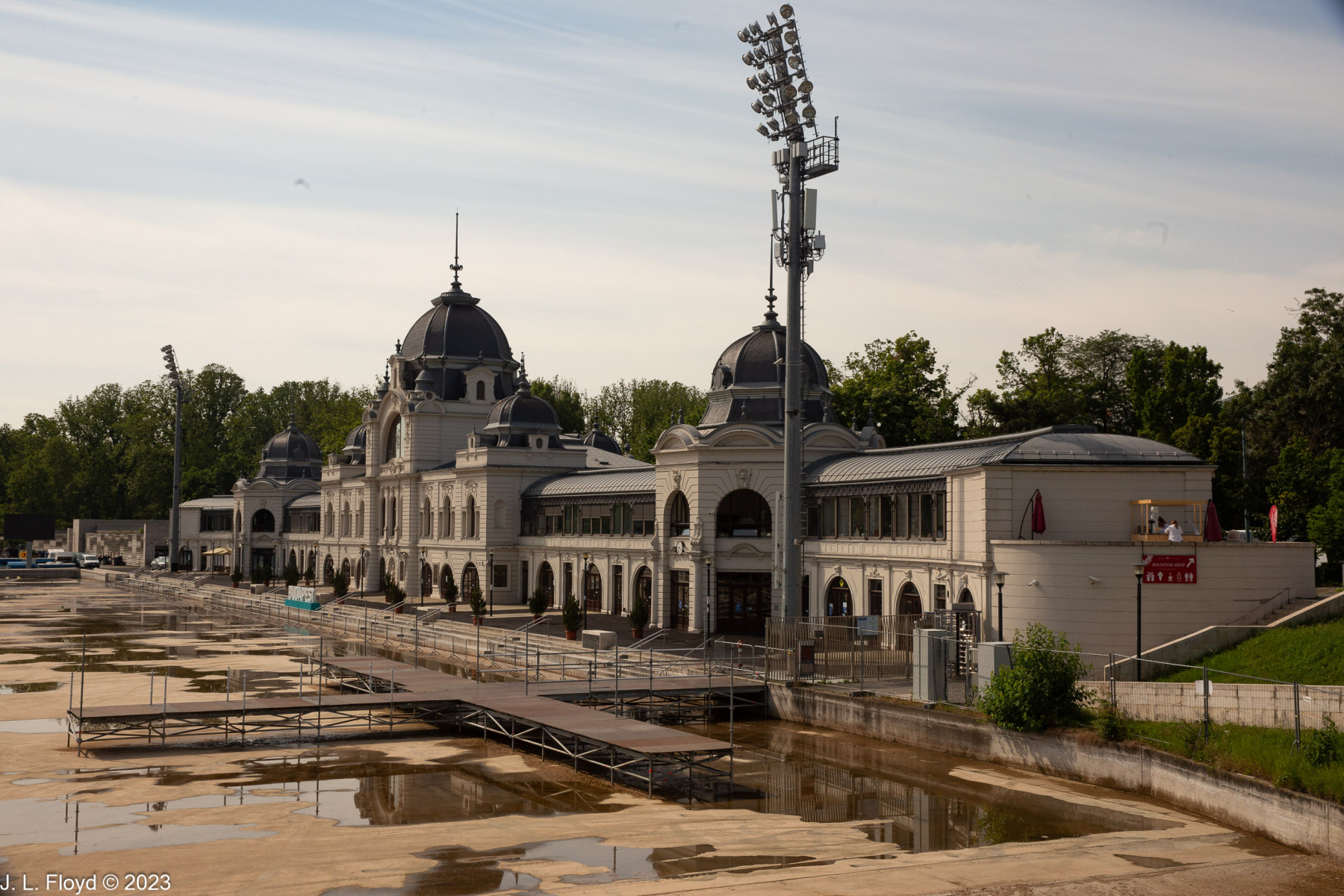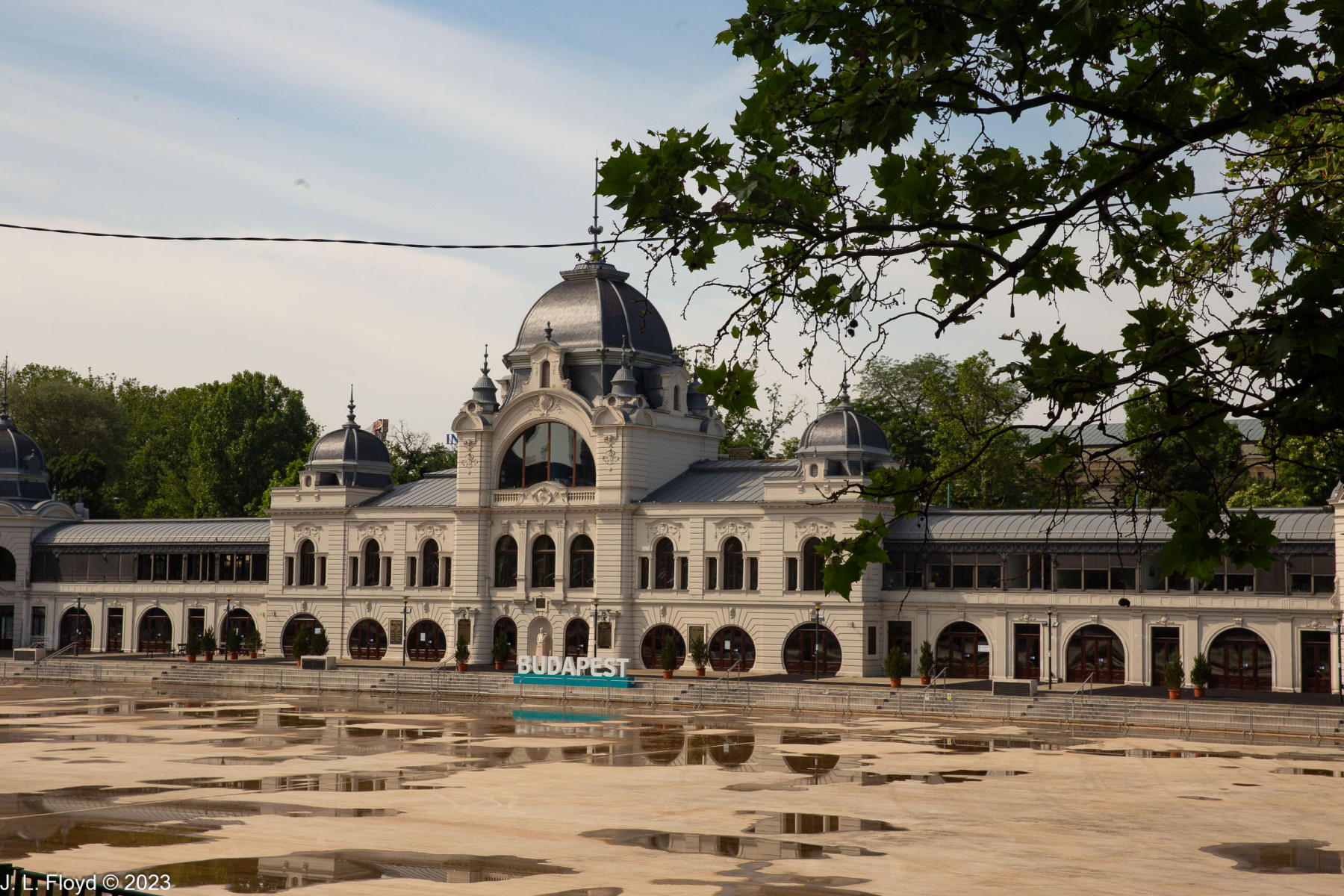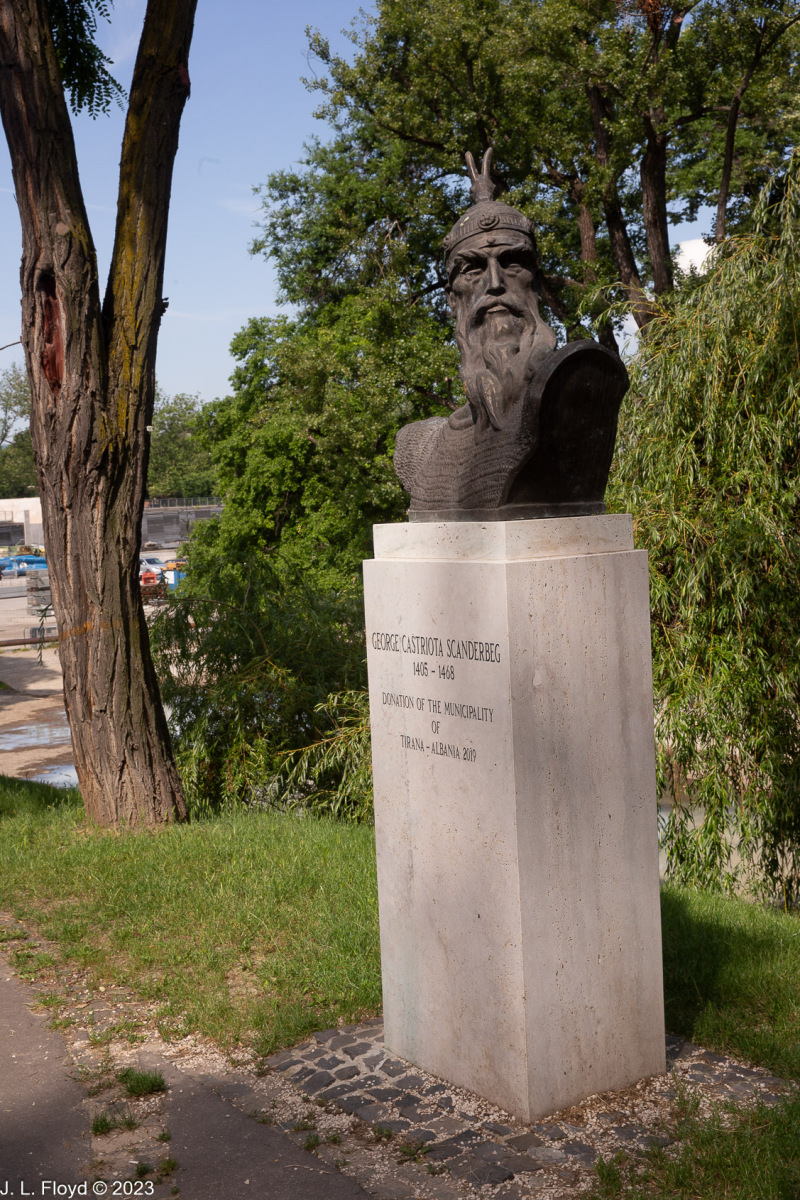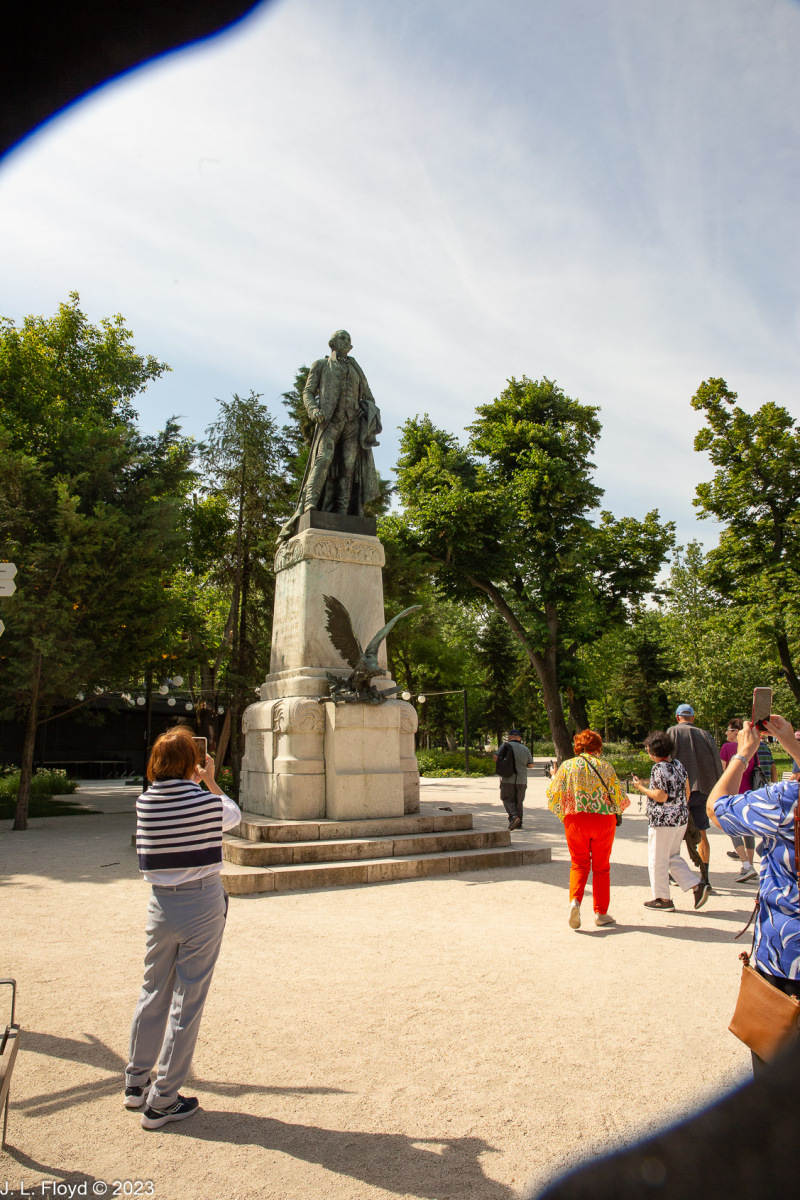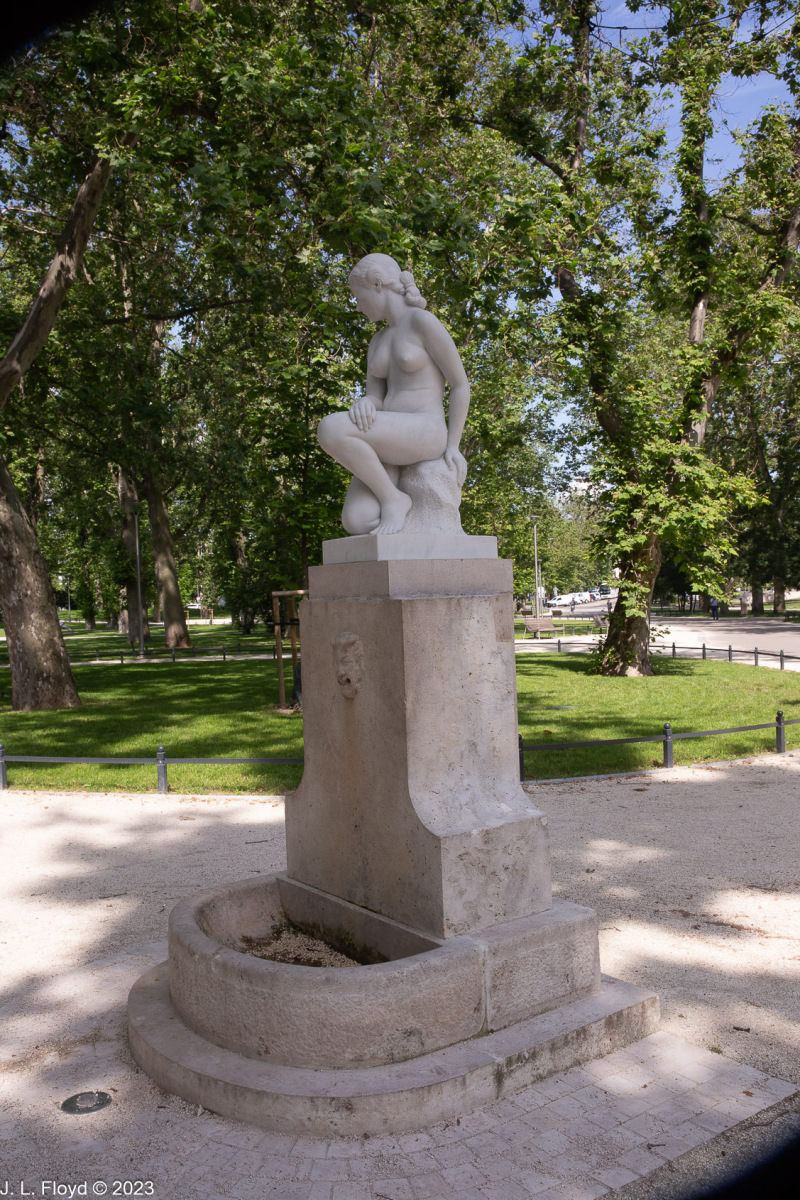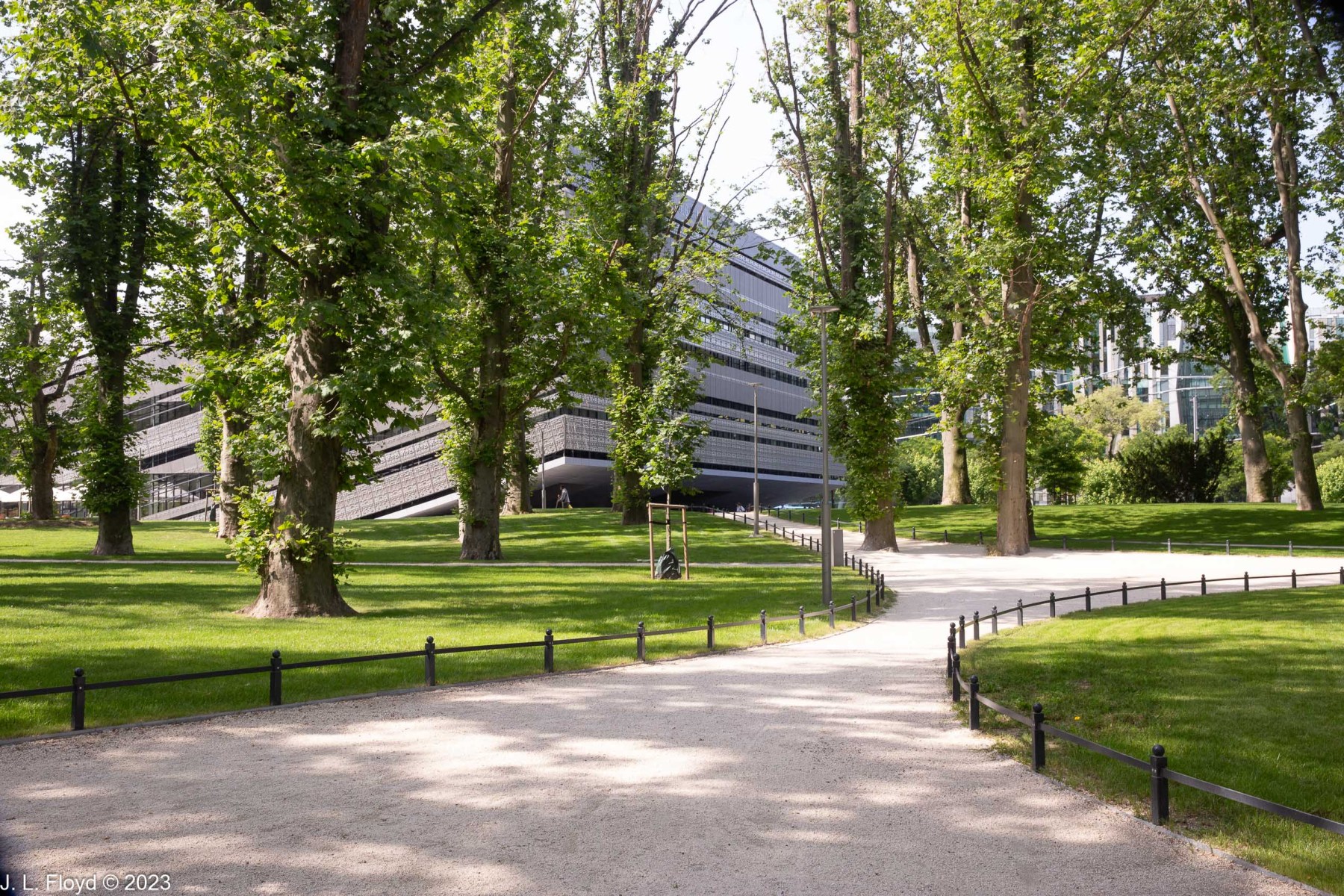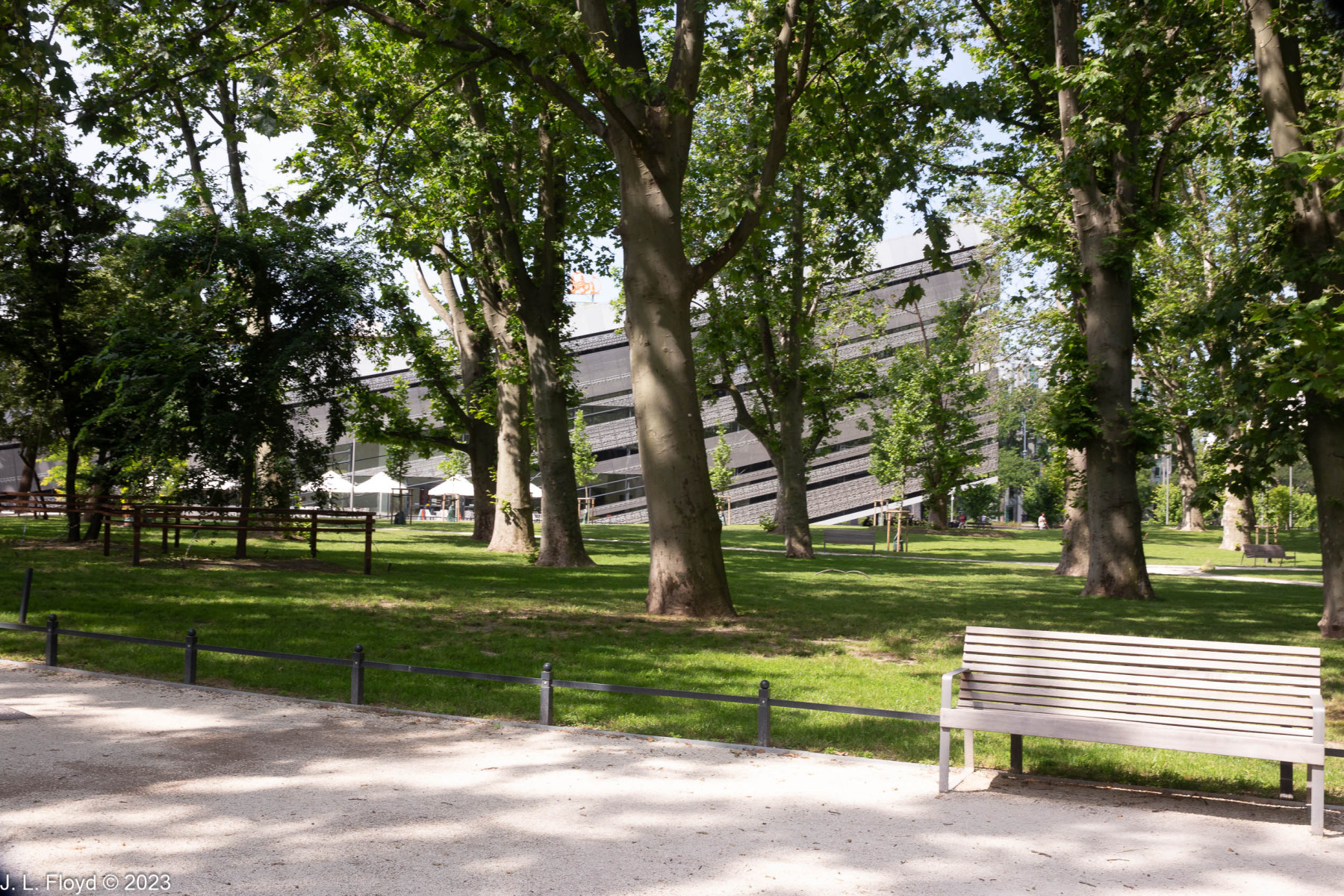Our first full day in Budapest began with a visit to Hősök tere, Heroes’ Square, where some of the major milestones of Hungarian history are memorialized.
The centerpiece of Heroes’ Square is the Millenium Column, 36 meters (118 feet) high, with a statue of the Archangel Gabriel on top, holding a crown in one hand and a two-barred apostolic cross in the other. At the base of the column are mounted figures representing the Seven Magyar Chieftains, a group of semi-legendary figures who are supposed to have led the ancestors of the Hungarians into the land they have occupied ever since. Other than Árpád, considered to be the founder of the Hungarian nation, little is known about these men, and there are many uncertainties about Árpád’s life as well. In any case the equestrian statues are not intended to be realistic depictions.
What is well known is that in the late ninth century CE, a group of nomadic tribes known as the Magyars established themselves in the Carpathian basin, in the territory known to the Romans as Pannonia. They had previously lived in the Pontic steppes, north of the Black Sea, where they had been a thorn in the side of the Slavic people who later became the Russians, and had been in their turn harassed by Turkic nomadic peoples such as the Khazars, Bulgars and Pechenegs. The Magyars themselves were not Turkic but spoke – and still speak – a Uralic language, akin to Finnish. They originated in Central Asia and Siberia, where some Uralic languages are still spoken today. However, as nomadic horsemen they necessarily led an existence similar to the neighboring Turkic tribes and consequently developed a similar social structure, and eventually some of those tribes joined them in their migrations.
In any case, partly under pressure from their enemies, the Magyars moved west of the Carpathians and settled in the plains of the trans-Danubian basin, where they then became a thorn in the side of the neighboring German, Slavic and Vlach (Romanian) peoples. They had a reputation as particularly savage fighters, raiding the villages, slaughtering all the men and carrying off the women and children. However, this could not last, and in 955 the German king Otto I, later Holy Roman Emperor, inflicted a shattering defeat on the Magyars in the Battle of Lechfeld, ending their forays into Germany. In the following half-century the Magyars began to settle down, adopt a more sedentary lifestyle and convert to Christianity.
In front of the Millenium Column in Heroes’ Square is a large stone cenotaph – a symbolic tomb not containing any actual remains – that serves as a memorial to all those who died in defense of Hungarian liberty and independence.
Behind the column is a pair of semicircular colonnades, each containing statues of major figures of Hungarian history, and topped with symbolic theme sculptures: outer edge of the left colonnade, a statue of a man with a scythe and a woman sowing seed, representing Labor and Wealth; on the inner edge, a male figure, representing War, driving a chariot using a snake as a whip. Opposite War on the right colonnade is a woman in a chariot holding a palm frond, personifying Peace, and on the outer edge of the right colonnade, statues of a man and a woman, representing Knowledge and Glory.
From Heroes’ Square we walked across a bridge over a mostly dry lake to Budapest City Park. The bridge, furnished with an elegant bronze railing, was designed by and named for Szilárd Zielinski, a Hungarian engineer who was a pioneer of reinforced concrete construction. Looming ahead of us in the park was a structure which for all the world looked like a castle out of a Dracula movie. This was the Vajdahunyadi Castle, which as far as I can tell means “Copy of Hunyadi Castle.” It was originally built in 1896 as part of an exhibition celebrating the millenial of the Magyar occupation of the Carpathian basin, and it was designed to incorporate features of various landmark buildings of Hungary – but above all the Hunyadi Castle (also known as Corvin Castle) in Transylvania, which was then part of the Kingdom of Hungary. Originally built of wood, it was later rebuilt in brick and stone, which was fortunate, since Hungary lost Transylvania to Romania, and with it Hunyadi Castle, in the aftermath of World War I. The Hungarians of course have never been happy about this, and they would prefer to have Transylvania back. John Hunyadi was a great military leader in 15th-century Hungary and is credited with successfully defending Transylvania against the seemingly unstoppable Ottoman Turks, who had conquered most of the Balkans as well as Constantinople by 1453. The castle which he built is one of the most magnificent in Europe and is now a major Romanian tourist attraction.
The copy in Budapest, though perhaps not as grand as the original, is no cheap imitation. It looks like someplace where Count Dracula might have felt at home. It now houses the Hungarian Museum of Agriculture. We did not go into the museum; our guide led us through the park on a different and longer path from the one on which we had come in, which brought us back to Heroes’ Square and our waiting bus.
Our stroll back to the bus took us past a number of interesting landmarks. Most unexpected was a statue of George Washington, which was erected in 1904, while Hungary was still part of the Habsburg Empire, as a symbol of Hungarian-American friendship.
It was a bit difficult to believe, in the heat of the summer, that Budapest is a major world center for ice skating, with the largest ice skating rink in Europe. The dry basin over which we had crossed to get to Vajdahunyadi Castle is actually that rink; it is supposed to be filled with water during the summer to serve as a boating lake, but apparently the hot dry weather experienced by Central Europe this summer put the kibosh on that. Nevertheless the neo-Baroque pavilion built in 1893 to preside over the rink and provide a place for skaters to change into their skating shoes is still quite imposing.
On the edge of the park, down the street from Heroes’ Square, we encountered a very unusual structure which turned out to be the brand-new home of the Hungarian Museum of Ethnography. This museum was founded in 1872 and has had many different homes; from 1975 to 2022 it was housed in the Palace of Justice (Hungarian Supreme Court) building on Kossuth Square, which we would visit two days later. The museum reputedly contains extraordinarily diverse and colorful collections of artifacts from all over the world, though its primary emphasis is on the folk culture of Hungary and other nationalities of the former Austro-Hungarian empire. But since we did not have time to go inside, it was the exterior that captured all our attention. It appears to be a huge curved ramp that slopes up from the ground, with a roof garden and walkway on top. The sloping sides are decorated with various folk motifs. I’ve never seen anything quite like it.
